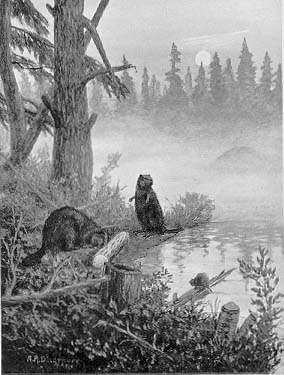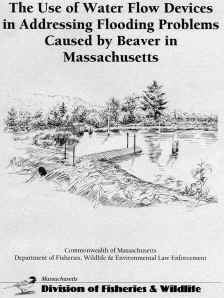 *
*  Order
this booklet
Order
this booklet "Beavers do more to shape their landscape than any other mammal except for human beings, and their ancestors were building dams ten million years ago."
Beavers seem to be everywhere in the northeast now. Almost any pond, lake, stream, or wetland seems to have a lodge or two occupying it. These guys are creating all kinds of new wetland habitat.
Guidelines for Controlling Beavers and Preventing Roadway Damage(a nice site with great illustrations)
"It is estimated that as many as two hundred million beavers once lived in the continental United States, their dams making meadows out of forests, their wetlands slowly capturing silt. The result of the beaver's engineering was a remarkably uniform buildup of organic material in the valleys, a checkerboard of meadows through the woodlands, and a great deal of edge, that fruitful zone where natural communities meet. Beavers are a keystone species, for where beavers build dams, the wetlands spread out behind them, providing home and food for dozens of species, from migrating ducks to moose, from fish to frogs to great blue herons."
"By damming streams, beaver raise the water level to surround their lodge with a protective moat, and also create the deep water needed for winter food storage in northern climes. While other wildlife endure wintertime cold and hunger, beaver stay warm in their lodges with an underwater food cache nearby. A beaver colony, often consisting of six or more including parents, yearlings and kits, coexists peacefully in a lodge with underwater access to the iced-up pond for four months or more."
"Because they breed once a year, require large streamside habitats, and two-year-olds leave home each spring to find their own territories, beaver rarely overpopulate. Small kits have many predators including hawks, owls, bobcat, coyote and dogs. Bear, wolves, dogs and coyote can also take adults"
"Like most wildlife, beaver self-regulate by starting to decrease their rate of reproduction when occupancy reaches a certain level. In vast areas without trapping, beaver populations may peak, and then slowly drift down to a sustainable level. Beaver in North America were almost extirpated by overtrapping in the early 1900s, and estimates of the current population are as low as 2.5% of those present prior to European settlement. Nonetheless, as beaver reclaim some former territory, conflicts with humans do arise."
Info on Beaver Damage Control * Massachusetts Wildlife Laws
For excellent assistance with Beaver Damage Control issues, contact Ruth and
Mike Callahan at the Clark Tavern in Hadley Massachsetts.
![]()
--------------------------------------------------------------------------------